History
 Imagine a people so dedicated to bringing their people home to be given a proper burial, that they would search for 31 years for a submarine that went missing with its 69 crew members, all considered lost sons of a nation. I know that many people wait years and never give up hope for the return of the remains of soldiers lost in battle, but this was a little bit different. The meant extensive searches and great expense…nevertheless, it was considered worth the cost. Imagine such a nation. Who would you think of? The United States maybe, or England? No, it is Israel.
Imagine a people so dedicated to bringing their people home to be given a proper burial, that they would search for 31 years for a submarine that went missing with its 69 crew members, all considered lost sons of a nation. I know that many people wait years and never give up hope for the return of the remains of soldiers lost in battle, but this was a little bit different. The meant extensive searches and great expense…nevertheless, it was considered worth the cost. Imagine such a nation. Who would you think of? The United States maybe, or England? No, it is Israel.
The submarine, INS Dakar was originally known as HMS Totem. It was built at the height of World War II by H.M. Dockyard in Great Britain. It was commissioned as the HMS Totem by the British navy in 1943. After the war ended, the submarine was modified, adding 12 feet to its length and removing some of its gun decks. The submarine was then sold to Israel along with two others in 1965. On November 10, 1967, the Israeli Navy officially launched Dakar. The submarine was tested in Scotland, and scheduled to go to Haifa, Israel for an official ceremony in early February, 1968. The crew had been ordered to check in daily, and they followed the orders implicitly. On January 24, 1968, Dakar passed the island of Crete and radioed its position for the last time. One additional signal came from Dakar just after midnight on January 25, 1968 and then…nothing. That was 48 years ago today.
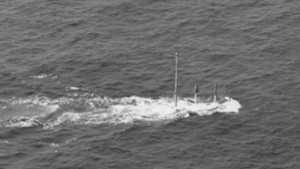
Israel launched 25 search missions over the 31 years following the loss of Dakar, but to no avail. The only sign of the submarine was one of her locator buoys that washed ashore off the coast of Khan Yunis a year after Dakar’s disappearance. Using that clue and the technology available at the time, those search missions resulted in the search of most of the Mediterranean Sea. The odd thing was that the searches never included the actual route that Dakar would have taken to Haifa. When the buoy was discovered, it was estimated that Dakar was 50 to 70 miles off course…hence the searches in the wrong places. Then, on 9 May 1999 two charted sea vessels arrived to finally search area along the original route. The designated search frames box area was approximately 60 nautical miles long, nearly 8 nautical miles wide and contained 16 search lanes. With a speed of 2 knots per hour it takes between 30 to 40 hours to monitor the sea bed of each search lane. Searching was conducted using the AMS-60, a wide-swath sonar and the REMORA 6000, a remotely operated vehicle equipped with both video and still cameras. On May 24th, in the evening, sonar detected a large body on the sea floor, along with several smaller bodies nearby. They launched the ROV at 7:00 on May 28th, after 3 days of weather delays, and finally found the Dakar four hours later.
There has been much speculation as to what caused the sinking and inevitable implosion of Dakar. Some say it  was a small leak that made control become impossible, but one Egyptian admiral has a different story to tell. Mohammed Abed el-Majid Azeb told various Egyptian sources that his crew identified the Israeli submarine during a training exercise. He decided to attack the vessel, which was in Egyptian territorial waters and and declared war on it. According to the report, Egyptian military commentators have suggested that the submarine was damaged by an Egyptian depth-charge and had to submerge, which could have been the leak they experienced. It’s hard to say after all these years, and we may never know, but I find it very interesting that the Israeli government would not give up until it could bring those lost sons home for a proper burial.
was a small leak that made control become impossible, but one Egyptian admiral has a different story to tell. Mohammed Abed el-Majid Azeb told various Egyptian sources that his crew identified the Israeli submarine during a training exercise. He decided to attack the vessel, which was in Egyptian territorial waters and and declared war on it. According to the report, Egyptian military commentators have suggested that the submarine was damaged by an Egyptian depth-charge and had to submerge, which could have been the leak they experienced. It’s hard to say after all these years, and we may never know, but I find it very interesting that the Israeli government would not give up until it could bring those lost sons home for a proper burial.
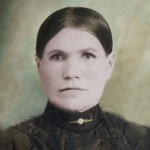 Things were quite different in the 1800s, as most of you know, but sometimes I wonder if we really understand how different they were. In about 1876 or so, my great grandmother, Henriette Schumacher, a girl of about 16 years, was sent by her widowed mother, with her sister to America. Her sister’s husband wanted to immigrate there, and since they had two little daughters, and Great Grandma’s mother was worried about her daughter going so far without help, she decided that since Henriette was not married she should go too. For their mother, there seemed to be safety in numbers, so it had to be better to send two girls instead of just one. I really can’t imagine the heartache she must have felt at that time. When my own daughter, Amy Royce moved to Washington state, I thought my heart would break…and yet I knew I would see her again, and that communication for us would be fairly easy. For my 2nd great grandmother, things were different. She didn’t know if she would see her daughters again, and I have no way to confirm that she did.
Things were quite different in the 1800s, as most of you know, but sometimes I wonder if we really understand how different they were. In about 1876 or so, my great grandmother, Henriette Schumacher, a girl of about 16 years, was sent by her widowed mother, with her sister to America. Her sister’s husband wanted to immigrate there, and since they had two little daughters, and Great Grandma’s mother was worried about her daughter going so far without help, she decided that since Henriette was not married she should go too. For their mother, there seemed to be safety in numbers, so it had to be better to send two girls instead of just one. I really can’t imagine the heartache she must have felt at that time. When my own daughter, Amy Royce moved to Washington state, I thought my heart would break…and yet I knew I would see her again, and that communication for us would be fairly easy. For my 2nd great grandmother, things were different. She didn’t know if she would see her daughters again, and I have no way to confirm that she did.
Still, many people were leaving the old country, in search of a dream life somewhere else. In that way, not much has changed at all. People still move from place to place, and sometimes country to country in search of some exciting new dream life. Some find what they are looking for, and others find out that what they were searching for was right there in front of them all along, so they return to their home. For my great grandmother, there didn’t seem to be much of a dream life waiting for her. She had a boyfriend back home, but things weren’t serous I suppose, because he didn’t follow her, and they never married. I think that for Great Grandma, Germany was comfortable. It was her home, and all she really knew. She didn’t have the wanderlust that her brother-in-law had. She couldn’t see that a life in America would be any better than the one she had in Germany, close to her family and friends. Nevertheless, go she must, so she said goodbye to all she knew, and headed off with her sister’s family to America.
In the end, she would find that her destiny was in America. It was there that she met my great grandfather, Carl Schumacher, who had immigrated a few years earlier. Their chance meeting when he stepped in for a baptismal sponsor who was unable to attend the baptism of Henriette’s sister’s daughter, brought Carl he 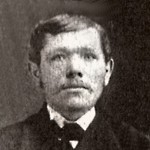 woman he would fall so completely in love with, that they would marry just a year later. I’m sure at that point, Henriette thought back to her prior boyfriend, and decided that their romance was a silly schoolgirl crush. Whoever he was, he could never have measured up to the man Carl was. Henriette wasn’t the same either. She was a world traveler now. She had lived in a wild new country. She had left home, grown up quickly, and had a degree of independence that her old beau would not have understood. Her world was different…things were different…she was different. He would never have been her choice now. Sometimes that is just how it goes. Our lives take turns that we didn’t plan on, and suddenly things are different. Then we have to live our life in the new reality that we live in. I’m sure that is how her mother felt too.
woman he would fall so completely in love with, that they would marry just a year later. I’m sure at that point, Henriette thought back to her prior boyfriend, and decided that their romance was a silly schoolgirl crush. Whoever he was, he could never have measured up to the man Carl was. Henriette wasn’t the same either. She was a world traveler now. She had lived in a wild new country. She had left home, grown up quickly, and had a degree of independence that her old beau would not have understood. Her world was different…things were different…she was different. He would never have been her choice now. Sometimes that is just how it goes. Our lives take turns that we didn’t plan on, and suddenly things are different. Then we have to live our life in the new reality that we live in. I’m sure that is how her mother felt too.
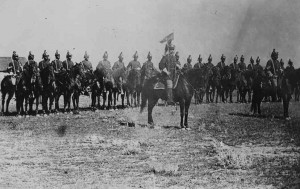 When I think of the Cavalry, I think of the Old West. The idea of men heading off to war mounted on horses, in today’s world seems completely crazy. In reality, it was precarious enough in the days of the Cowboys and Indians, but even more so with guided missiles, tanks, roadside bombs, and suitcase bombs…just to name a few. I realize that those weapons have evolved slowly, but the Cavalry probably rode horses well past the point when it was safe for them to do so. Nevertheless, the reality is that many of the men had no desire to give up their horse for the alternative in 1941, but that was what they were told to do, and so they did…many with tearful sadness to show for it. They followed their orders, with minimal grumbling, because things like that could get a guy in trouble. Still, the goodbyes were tearful, even if the tears had to be held until the soldier was alone.
When I think of the Cavalry, I think of the Old West. The idea of men heading off to war mounted on horses, in today’s world seems completely crazy. In reality, it was precarious enough in the days of the Cowboys and Indians, but even more so with guided missiles, tanks, roadside bombs, and suitcase bombs…just to name a few. I realize that those weapons have evolved slowly, but the Cavalry probably rode horses well past the point when it was safe for them to do so. Nevertheless, the reality is that many of the men had no desire to give up their horse for the alternative in 1941, but that was what they were told to do, and so they did…many with tearful sadness to show for it. They followed their orders, with minimal grumbling, because things like that could get a guy in trouble. Still, the goodbyes were tearful, even if the tears had to be held until the soldier was alone.
Of course, we know, as did they, that the weapons that were being lobbed at them were far more sophisticated than they had been in the early years, but they had come to trust their horse to get them out of the place that found themselves in. In reality, that was becoming harder and harder for the horse. Remember that any weapon that was lobbed at the rider, was also lobbed at the horse. It was hard to hit one and miss the other. A tank on the other hand was often invincible against many of the weapons back when the tank was invented. It was in the best interest of the soldier to give up his mount, but it was fully understood that it was also one of the hardest things they would ever have to do.
Troop F stationed at Douglas, Wyoming would be one of the last troops to be required to give up their horses. Their horses were stunning black Morgan horses, and this troop was proud of their horses, and their duties. One duty of which they were especially proud was when they escorted the Governor at state events. The riders were in their dress white uniforms, and even the horses were dressed up in white. The horses were so proud of their duties, and they knew them better than the rookies who were riding them. When the men presented their 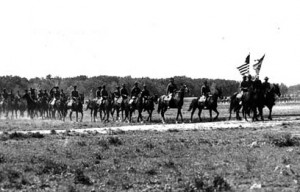 shining sabers, the horses would prance sideways in an elaborate display of discipline. For the men who worked with the beautiful horses daily, the thought of never mounting up again was…well, devastating.
shining sabers, the horses would prance sideways in an elaborate display of discipline. For the men who worked with the beautiful horses daily, the thought of never mounting up again was…well, devastating.
Nevertheless, in the end, the men lost their horses to the modern world and modern machines. While it was not the preferred situation, the men knew that times were changing and they would either have to change with the times, or become dinosaurs of the past. I suppose that most of them would continue on, because that is what soldiers do. They came to serve their country, and they would not let their final dismount be their final act in the service.
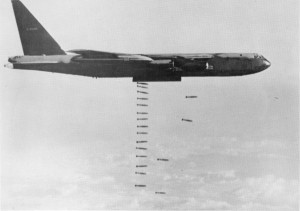 Because our world seems always to be at war, it is an unfortunate reality that bombs will exist…some legal, made for our military to keep us safe, some legal to blow up things for construction and other things, and of course some illegal, meant to bring terror and destruction. When I think about most bombs, the word terror definitely comes to the surface…be the bomb legal or not. Never is that more of a thought that when I think about the possibility of a bomb being lost, especially due to a plane crash. During the Cold War, as a means of maintaining first-strike capability, United States bombers carrying nuclear weapons circled the earth constantly…for decades. We just never knew when we could be attacked. We had to be…always ready.
Because our world seems always to be at war, it is an unfortunate reality that bombs will exist…some legal, made for our military to keep us safe, some legal to blow up things for construction and other things, and of course some illegal, meant to bring terror and destruction. When I think about most bombs, the word terror definitely comes to the surface…be the bomb legal or not. Never is that more of a thought that when I think about the possibility of a bomb being lost, especially due to a plane crash. During the Cold War, as a means of maintaining first-strike capability, United States bombers carrying nuclear weapons circled the earth constantly…for decades. We just never knew when we could be attacked. We had to be…always ready.
The problem with planes carrying bombs and in the air constantly, is the possibility of crashes. My thought, when a bomber crashes, is what happens to the bomb. In all reality, it’s a good question. There have been about three dozen accidents in which bombers either crashed or caught fire on the runway, resulting in nuclear contamination from a damaged or destroyed bomb and/or the loss of a nuclear weapon. We don’t often hear about these…especially when they happen in the United States, but let one happen in another country, and it’s a different story. When one of these bombs was lost, it was called a Broken Arrow, mainly to avoid panic, I’m sure. One of the only Broken Arrows to receive widespread publicity occurred on January 17, 1966. A B-52 bomber crashed into a KC-135 jet tanker over Spain.
The bomber was on route to its base in North Carolina, when the crash occurred dropping three 70 kiloton hydrogen bombs near the town of Palomares and one in the sea. The KC-135 was attempting to refuel the B-52, when the B-52 collided with the fueling boom. The fuel was ignited and the KC-135 blew up, killing its crew. Four of the seven crew members of the B-52 managed to parachute to safety…the rest were lost. The bombs were not armed, but with the first two, the explosive material exploded on impact, forming craters and scattering radioactive plutonium over the fields of Palomares. One bomb landed in a dry riverbed and remained intact, and the fourth landed in the sea. No one knew for sure where it was. The cleanup was massive.
Locating the bomb that had fallen into the sea took a bit longer. The Navy used an IBM computer, and experts tried to calculate where the bomb might have landed. They were very handicapped because of the size of the  impact area. Finally, a Spanish fisherman gave an eyewitness account that proved to be so accurate that on March 15th, with a much smaller search area, a submarine spotted the bomb. The bomb was recovered on April 7th, damaged but intact, and everyone breathed a sigh of relief. This particular accident was widely reported, because it was on foreign soil. It makes me wonder why there is so little reporting on American soil Broken Arrows. To this day, two hydrogen bombs and a uranium core lie in yet undetermined locations in the Wassaw Sound off Georgia, in the Puget Sound off Washington, and in swamplands near Goldsboro, North Carolina. I suppose some people knew of these lost bombs before, but I did not…until now.
impact area. Finally, a Spanish fisherman gave an eyewitness account that proved to be so accurate that on March 15th, with a much smaller search area, a submarine spotted the bomb. The bomb was recovered on April 7th, damaged but intact, and everyone breathed a sigh of relief. This particular accident was widely reported, because it was on foreign soil. It makes me wonder why there is so little reporting on American soil Broken Arrows. To this day, two hydrogen bombs and a uranium core lie in yet undetermined locations in the Wassaw Sound off Georgia, in the Puget Sound off Washington, and in swamplands near Goldsboro, North Carolina. I suppose some people knew of these lost bombs before, but I did not…until now.
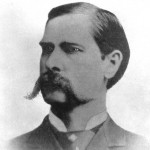 Growing up, my sisters and I watched lots of westerns. It wasn’t so strange really, because westerns were the in thing back then. Everyone loved watching them. One show I remember watching was The Gunfight at the O.K. Corral. It all seemed like it took place so long ago, and to many people I guess it was. Still, when you think of the fact that Wyatt Earp, a frontiersman, marshal and gambler, who got into a feud in Tombstone, Arizona, that led to the famous gunfight at the O.K. Corral passed away quietly in Los Angeles on January 13, 1929, it doesn’t seem so long ago anymore. I guess that in Wyatt Earp’s case, old gunfighters never die, they just lose their fight. Wyatt Earp was born on March 19, 1848, and that seems long ago. The gunfight took place on October 26, 1881…and Wyatt Earp survived. He had led such a wild life, that the thought of him ending up dying quietly in Los Angeles seemed…well, just too tame, and just too much a part of modern times to be right. Nevertheless, it was right. He did live in modern times, and in fact was a friend of John Wayne’s.
Growing up, my sisters and I watched lots of westerns. It wasn’t so strange really, because westerns were the in thing back then. Everyone loved watching them. One show I remember watching was The Gunfight at the O.K. Corral. It all seemed like it took place so long ago, and to many people I guess it was. Still, when you think of the fact that Wyatt Earp, a frontiersman, marshal and gambler, who got into a feud in Tombstone, Arizona, that led to the famous gunfight at the O.K. Corral passed away quietly in Los Angeles on January 13, 1929, it doesn’t seem so long ago anymore. I guess that in Wyatt Earp’s case, old gunfighters never die, they just lose their fight. Wyatt Earp was born on March 19, 1848, and that seems long ago. The gunfight took place on October 26, 1881…and Wyatt Earp survived. He had led such a wild life, that the thought of him ending up dying quietly in Los Angeles seemed…well, just too tame, and just too much a part of modern times to be right. Nevertheless, it was right. He did live in modern times, and in fact was a friend of John Wayne’s.
I’m not sure why that whole scenario struck me as odd. Wyatt Earp was 80 years old at the time of his passing…not an overly excessive amount of years…average, in fact. Since he was born in 1848, his passing in 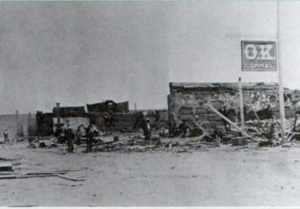 1929 would be right. I guess that the thing that seemed strange to me was the fact that when Wyatt Earp passed away, my own dad was five years old. Yes, he was an old man, and my dad a young boy, but for those five years, their life spans occupied the same space in history. And yet, my dad’s life had no connection to the time of Wyatt Earp, or to the man that he was.
1929 would be right. I guess that the thing that seemed strange to me was the fact that when Wyatt Earp passed away, my own dad was five years old. Yes, he was an old man, and my dad a young boy, but for those five years, their life spans occupied the same space in history. And yet, my dad’s life had no connection to the time of Wyatt Earp, or to the man that he was.
Wyatt Earp was a boy in search of adventure, and ran away from home twice after the Civil War broke out when he was 13. He went to join up with his two older brothers, Virgil and James. Each time he ran away, he was caught before he could reach the battlefield, and he was sent back home. Finally, at the age of 17, he left for good. His family had moved from the Illinois farm to California, but Wyatt wanted adventure, so he headed out to seek his own idea of life. He worked many different jobs, most notably as a lawman, and of course, a gambler. Life was not kind to Wyatt Earp. At a point when he was finally ready to settle down with the woman he loved, he married Urilla Sutherland, the daughter of the local hotel owner. The couple married about 1870, built a house in town, and were excitedly awaiting the birth of their first child. Then, life hit him with it’s most 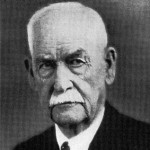 cruel blow. Within a year of their marriage Urilla contracted Typhus and died, along with their unborn child. Wyatt went off the deep end and became wild again. Eventually, he would be suspected of killing one of the suspects in his brother, Morgan’s death.
cruel blow. Within a year of their marriage Urilla contracted Typhus and died, along with their unborn child. Wyatt went off the deep end and became wild again. Eventually, he would be suspected of killing one of the suspects in his brother, Morgan’s death.
Unfortunately…or maybe fortunately, the west began to settle down. Wyatt was getting older. He settled in Los Angeles and hoped to have the Old West and his own legacy portrayed in film, but Hollywood wasn’t interested until after his death. I suppose it was then that Westerns moved into the forefront of television and movies. Westerns would then have a long run of popularity in the homes of many people…ours included.

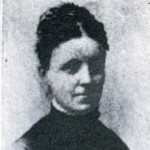 It would be hard for me to imagine walking away from all I knew to travel to India to begin a thirteen year run as the wife of a missionary, especially in 1874, but that is exactly what Mary Barr Uhl did. Mary was a somewhat distant cousin on my husband, Bob’s side of the family…specifically the Knox side of his family. The beginnings of her future mission were actually laid by when she was still a child. An elderly relative, Dr John Scudder laid his hand on her head and stated his wish for her to become a missionary. I’m sure that for a little girl, being a missionary meant very little, but as she grew, perhaps the words stayed with her. Sometimes, when we think about something like that for so many years, events in our lives line up to put us in exactly the right position to fulfill just such a mission, without our really thinking about it very much at all. Such was the case for little Mary Barr.
It would be hard for me to imagine walking away from all I knew to travel to India to begin a thirteen year run as the wife of a missionary, especially in 1874, but that is exactly what Mary Barr Uhl did. Mary was a somewhat distant cousin on my husband, Bob’s side of the family…specifically the Knox side of his family. The beginnings of her future mission were actually laid by when she was still a child. An elderly relative, Dr John Scudder laid his hand on her head and stated his wish for her to become a missionary. I’m sure that for a little girl, being a missionary meant very little, but as she grew, perhaps the words stayed with her. Sometimes, when we think about something like that for so many years, events in our lives line up to put us in exactly the right position to fulfill just such a mission, without our really thinking about it very much at all. Such was the case for little Mary Barr.
Mary Barr was born in Savannah, Ohio, and was educated there and in Springfield, Ohio. As was the case with most girls in those days, becoming a teacher was the degree of choice, and so Mary Barr became a teacher. As time went by, it’s possible that the desire of the elderly Dr John Scudder to have Mary become a missionary, faded into the past to a degree, until she met Lemon Leander Uhl. Leander as he was called, was a pastor in the Lutheran church. Dr Uhl was a graduate of Wittenberg College and Seminary in Springfield, Ohio, and did his post graduate work at John Hopkins University in Baltimore, Maryland. The couple married in the fall of 1872, and Dr Uhl became a missionary in the India field of the General Synod, Lutheran Church. Thus, the desire of Mary’s relative, Dr John Scudder, became a reality. Leander and Mary would spend the next thirteen years in the mission field in India. Mary and Leander arrived in Guntur, India in March of 1873. Mary opened the first school for girls of the upper classes and the first Zenana work for the same classes. She carried on both forms of mission work for many years. Mary’s perseverance and dedication won her great respect in that country. She was an untiring worker among the Telugu Hindus, and aided her husband in the Anglo Vernacular School by visiting the young men students in their homes.
Mary and Leander’s only child, Grace was born in Guntur, India during those missionary years. That is another thing I can’t quite imagine…having my baby so far away from my mother, and the doctors that I trusted in the United States, but by then, perhaps Mary felt comfortable with the help she had around her. It didn’t matter really, because she had no choice. You can’t stop babies from coming when it’s time. You just have to go through it. For Mary, childbirth went well, and she had a beautiful little daughter. It was by the grace of God, and so they named her Grace. While I’m sure that giving birth in a foreign country might have been an event filled with apprehension, the life they gave their daughter was one of many experiences. Not only did Grace experience life in another country, but she experienced schooling in many places. Grace would graduate from the College of Liberal Arts of Boston University in Boston, Massachusetts.
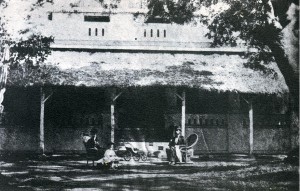
Mary Barr Uhl’s life took many turns that might have seemed far fetched to a child, who had been told of the desire of an elderly relative, but in the end, the desire of Dr John Scudder, that little Mary Barr would become a missionary had come to pass. Her life was not ruled by this man, it was just his desire…that became her desire too. Perhaps he saw something in that little girl that told him that she would be a great missionary. I suppose we will never know, but Mary did indeed, become a great missionary, and spent many years serving God in that capacity before retiring and returning to the United States. She died on March 26, 1926 at the age of 80 years, having fulfilled her destiny.
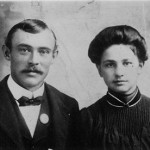
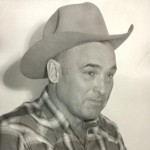 My curiosity about some of the family members on my husband, Bob’s side of our family, has led me to research the Forsyth, Montana area, because after all, that is where many of them lived for much of their lives. Some, including Julia (Doll) Schulenberg, and her husband, Max homesteaded here, until floods and droughts ruined their chances of making a living there. Then they moved into the little town of Forsyth, Montana, where they would live out their lives and raise their ten children, the oldest of whom was my husband, Bob’s grandfather, Andrew Schulenberg. Andy was the sheriff of Rosebud County from 1955 to 1972, in spite of the fact that he had lost his lower leg in a shooting accident when he was fifteen years old. To me that is rather an amazing feat for the times. Artificial legs of this day and age could probably facilitate an officer of the law’s need to run, but in those days, they did not have the technology to spring load the leg for running. During his term as sheriff, Andy became a much loved sheriff and citizen of the area, while also keeping the peace in the county.
My curiosity about some of the family members on my husband, Bob’s side of our family, has led me to research the Forsyth, Montana area, because after all, that is where many of them lived for much of their lives. Some, including Julia (Doll) Schulenberg, and her husband, Max homesteaded here, until floods and droughts ruined their chances of making a living there. Then they moved into the little town of Forsyth, Montana, where they would live out their lives and raise their ten children, the oldest of whom was my husband, Bob’s grandfather, Andrew Schulenberg. Andy was the sheriff of Rosebud County from 1955 to 1972, in spite of the fact that he had lost his lower leg in a shooting accident when he was fifteen years old. To me that is rather an amazing feat for the times. Artificial legs of this day and age could probably facilitate an officer of the law’s need to run, but in those days, they did not have the technology to spring load the leg for running. During his term as sheriff, Andy became a much loved sheriff and citizen of the area, while also keeping the peace in the county.
Before the town of Forsyth, Montana existed, the river steamers used to stop in the area to refuel their engines. The area had an abundance of cottonwood trees and that made it a perfect fuel location. To this day, Forsyth is known as the city of trees. The town sits along the Yellowstone River, and it got its name from General James W Forsyth, who stopped there on one of those river steamers, before there was even a town. The town would be established in 1880, and the post office would be established in 1882 when the Northern Pacific Railroad extended into the Judith Basin, which opened up the territory for settlement. It is located along 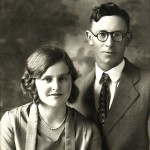
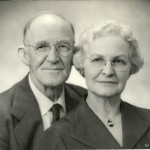 the Lewis and Clark Trail, which peaks my curiosity even more.
the Lewis and Clark Trail, which peaks my curiosity even more.
Max and Julia Schulenberg weren’t the only side of Bob’s family to settle in Forsyth. The Knox side of the family lived there too. Shortly after the death of their son, Joy Allen Knox, Bob’s maternal great grandparents, Edgar and Nellie (DeGood) Knox, moved from Prosser County, Washington to the Rosebud area to work on a ranch there. While Bob’s grandfather was not born in the area, he lived there until the early 1960s when they would move to Casper, Wyoming, which is where their daughter, Joann and her husband, Walter Schulenberg, who are Bob’s parents had moved. While Walt and Joann would never live in Montana again, Forsyth would remain an important part of their lives. Forsyth was, after all, an area where they had deep roots, connected to both sides of their family. With the move of the Knox family, the connection to Forsyth for that side of the family ended, however. Still the Schulenberg/Hein/Leary side of the family continues to have deep roots there to this day, and a number of the family members still live right there in Forsyth.
One of the things that I had always found very interesting about Forsyth is the cross on the hill. I always thought it was great that the town had decided to place the cross there, but now I find out that it was not the town at all. The cross, which has become a tourist attraction, as well as a source of inspiration and hope for the people of the area, was actually placed there early in the Fall of 1960 by the youth group of Concordia Lutheran Church. The idea was that of one of the youth group members, and was so well received by the entire 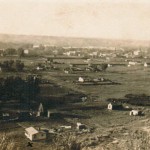
 youth group, that they all gave up their Saturdays to dig the hole for the pole and the anchor on the top of the hill to the south of Forsyth. The cross was first lit up on the second Monday evening in November of 1960. Over the next sixteen years, the cross remained lit and was kept up by contributions from individuals, businesses, tourists and organizations. I’m not sure if it is still lit these days, but it remains on the top of the hill. I’m sure there is much more history that I will discover as I continue to study the area where Bob’s family has such deep roots. I look forward to doing more research very soon.
youth group, that they all gave up their Saturdays to dig the hole for the pole and the anchor on the top of the hill to the south of Forsyth. The cross was first lit up on the second Monday evening in November of 1960. Over the next sixteen years, the cross remained lit and was kept up by contributions from individuals, businesses, tourists and organizations. I’m not sure if it is still lit these days, but it remains on the top of the hill. I’m sure there is much more history that I will discover as I continue to study the area where Bob’s family has such deep roots. I look forward to doing more research very soon.
 A couple of years ago, my mom, Collene Spencer, my sister, Cheryl Masterson, and I made a trip back to Superior, Wisconsin and Duluth, Minnesota to reconnect, and meet family members there. We had a wonderful trip, and both my sister and I have found sites on Facebook that display pictures of the area. Cheryl and I were both born in Superior, Wisconsin, so we feel a closeness to the area, even though we have not lived there for many years. It is still the area of our roots. Now that we have been back in a more recent time, a continue to feel drawn to the area. The strange thing is that the things I am interested in at this time, are more historic things…some of them, things that no longer exist. In my memory, we didn’t spend a lot of time in Duluth, but I’m probably mistaken on that count…at least to a degree. Superior, Wisconsin and Duluth, Minnesota are so close to each other, that if there were no signs to tell you so, you might not realize that you have left one and entered the other. I’m sure my parents shopped in Duluth, simply because as the larger of the two cities, there was quite likely more variety there.
A couple of years ago, my mom, Collene Spencer, my sister, Cheryl Masterson, and I made a trip back to Superior, Wisconsin and Duluth, Minnesota to reconnect, and meet family members there. We had a wonderful trip, and both my sister and I have found sites on Facebook that display pictures of the area. Cheryl and I were both born in Superior, Wisconsin, so we feel a closeness to the area, even though we have not lived there for many years. It is still the area of our roots. Now that we have been back in a more recent time, a continue to feel drawn to the area. The strange thing is that the things I am interested in at this time, are more historic things…some of them, things that no longer exist. In my memory, we didn’t spend a lot of time in Duluth, but I’m probably mistaken on that count…at least to a degree. Superior, Wisconsin and Duluth, Minnesota are so close to each other, that if there were no signs to tell you so, you might not realize that you have left one and entered the other. I’m sure my parents shopped in Duluth, simply because as the larger of the two cities, there was quite likely more variety there.
Recently, I started looking into some of the history of that general area, and stumbled on something  interesting. Duluth had an incline railway. Personally, I like incline railways, but I have never seen one that was in a city. Incline railways seem more like something that you would see at a tourist attractions, than anything that you would use in everyday life. Nevertheless, Duluth, in 1891, had a streetcar line, and in December 1891, the Duluth Street Railway Company opened the incline railway, as part of that street car line. The Incline Railway was on the right-of-way of Seventh Avenue West. The Duluth Street Railway Company had received a charter from the state in 1881 to build a streetcar line for Duluth. The hillside on Seventh Avenue West was too steep for a regular rail line, so they built an incline railway for that area. From it’s base station on Superior Street, the Incline climbed 509 feet in slightly more than half a mile, on a ten foot gauge track. Originally, a pair of forty one by fifteen foot cars counterbalanced each other, one going up while the other one descended. They were built to accommodate four teams and wagons, or up to 250 standing passengers. The Incline was powered by a stationary steam engine at the top. The trip took sixteen minutes, one way…just enough time to make it an enjoyable trip.
interesting. Duluth had an incline railway. Personally, I like incline railways, but I have never seen one that was in a city. Incline railways seem more like something that you would see at a tourist attractions, than anything that you would use in everyday life. Nevertheless, Duluth, in 1891, had a streetcar line, and in December 1891, the Duluth Street Railway Company opened the incline railway, as part of that street car line. The Incline Railway was on the right-of-way of Seventh Avenue West. The Duluth Street Railway Company had received a charter from the state in 1881 to build a streetcar line for Duluth. The hillside on Seventh Avenue West was too steep for a regular rail line, so they built an incline railway for that area. From it’s base station on Superior Street, the Incline climbed 509 feet in slightly more than half a mile, on a ten foot gauge track. Originally, a pair of forty one by fifteen foot cars counterbalanced each other, one going up while the other one descended. They were built to accommodate four teams and wagons, or up to 250 standing passengers. The Incline was powered by a stationary steam engine at the top. The trip took sixteen minutes, one way…just enough time to make it an enjoyable trip.
In 1925, it was noted that the Incline carried an average of 2,170 weekday passengers, while the connecting 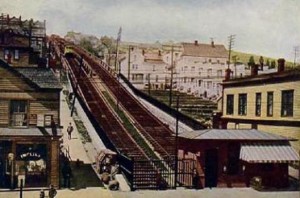 Highland streetcar line carried an average of only 1,114 weekday passengers. I’m sure that was because people like incline railways…they are unique….besides, climbing that hill would not be fun. Hourly checks showed that most riders traveled downhill in the morning rush hour and uphill during the afternoon rush hour. Most likely they were commuting to and from work. The Duluth Incline Railway was never profitable. Nevertheless, it and the Highland line were the last remnants of the streetcar system to be replaced by buses. Their last day of service was September 4, 1939. For that reason, I’m sure that many of the current residents of Duluth don’t even know about the incline railroad. I didn’t either, until I stumbled on it.
Highland streetcar line carried an average of only 1,114 weekday passengers. I’m sure that was because people like incline railways…they are unique….besides, climbing that hill would not be fun. Hourly checks showed that most riders traveled downhill in the morning rush hour and uphill during the afternoon rush hour. Most likely they were commuting to and from work. The Duluth Incline Railway was never profitable. Nevertheless, it and the Highland line were the last remnants of the streetcar system to be replaced by buses. Their last day of service was September 4, 1939. For that reason, I’m sure that many of the current residents of Duluth don’t even know about the incline railroad. I didn’t either, until I stumbled on it.
 As kids growing up, my sisters and I were subjected to many stories, view, songs, and events that centered around the Old West. When I say subjected, I don’t mean that we hated every minute of I, because we didn’t. We lived in Wyoming, and therefore we embraced the Old West. I can’t say that my sisters and I always liked all things western, because that would be false too. We all went through our Rock and Roll era, and during that time, we pretty much hated Country music, although shows like Bonanza, the Rifleman, Wagon Train, and The Virginian…just to name a few, were among our favorites, and we each had our favorite actors, and we were going to “marry” them. I know, silly…right?
As kids growing up, my sisters and I were subjected to many stories, view, songs, and events that centered around the Old West. When I say subjected, I don’t mean that we hated every minute of I, because we didn’t. We lived in Wyoming, and therefore we embraced the Old West. I can’t say that my sisters and I always liked all things western, because that would be false too. We all went through our Rock and Roll era, and during that time, we pretty much hated Country music, although shows like Bonanza, the Rifleman, Wagon Train, and The Virginian…just to name a few, were among our favorites, and we each had our favorite actors, and we were going to “marry” them. I know, silly…right?
Back then, the Old West was still considered something that people were proud to know about, or even to know people who lived those times. It was the times that our grandparents grew up in, and that 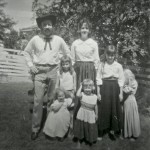 made it even more cool. I don’t suppose that the kids of today look back on the Old West or even the 1950s, 1960s, or 1970s, as being cool, because those times were before personal computers and cell phones, so I’m sure it seemed like the dark ages to the kids of today. Those years were probably best known for protests…unless you compare that era to today’s, when everyone is so offended by everything. Even when I look back on my childhood years, I can’t say that I think we as a generation did anything so amazing…at least not until we grew up, because of course, it is our generation that invented the computer and cell phone. Nevertheless, it was a vastly different era that the Old West…or maybe that’s just my opinion.
made it even more cool. I don’t suppose that the kids of today look back on the Old West or even the 1950s, 1960s, or 1970s, as being cool, because those times were before personal computers and cell phones, so I’m sure it seemed like the dark ages to the kids of today. Those years were probably best known for protests…unless you compare that era to today’s, when everyone is so offended by everything. Even when I look back on my childhood years, I can’t say that I think we as a generation did anything so amazing…at least not until we grew up, because of course, it is our generation that invented the computer and cell phone. Nevertheless, it was a vastly different era that the Old West…or maybe that’s just my opinion.
While we were little, many of the cities and states were celebrating their centennial years, and it was a big deal!! Contests were held to see who could grow the best beard, and I’m sure who had the best Old Western costume. My Dad, Allen Spencer, decided to grow a beard for the competition. I don’t know if he won or not, or even if he entered any contest at all, but he got in on the festivities…as did Dad’s girls. We each had a long dress, much like the women of the Old West wore, and our parents took pictures to document the events. It was a great time, and they made sure that they had plenty of pictures of it.
These days, you seldom hear of such events. I don’t know if states or cities are 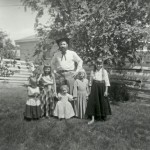 just not at the right point, or if many people have just lost interest, or what has happened exactly, but you don’t see these things happening. I find that sad, because our family found it to be very fun and interesting. Of course, there are still reinactments of old western robberies, the pony express, and wagons west trips, and I think those would be fun, but for some reason that centennial just seemed different…more interesting somehow…like we were a real pioneer family.
just not at the right point, or if many people have just lost interest, or what has happened exactly, but you don’t see these things happening. I find that sad, because our family found it to be very fun and interesting. Of course, there are still reinactments of old western robberies, the pony express, and wagons west trips, and I think those would be fun, but for some reason that centennial just seemed different…more interesting somehow…like we were a real pioneer family.
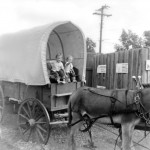 Over the years of our childhood, my sisters and I were exposed to the history of this great nation. Mom and Dad loved the things that showcased the Old West, including Country Music, old western movies, and western books, but they mostly wanted to show us the places where the Old West really happened. Of course, some of the places were replicas of the real thing, such as Wall Drug. Any time we went through South Dakota and there was enough time, we stopped at Wall Drug. It’s funny to think that a drug store could be called a tourist attraction, but with all the wagons, horse statues, and photo boards, people come just to see the sights in the drug store. Wall Drug is in the town of Wall, South Dakota…a huge town of 906 people…and that is today, so I’m sure it was much smaller when I was a little girl. In fact, I don’t recall anything about the town of Wall…just the drug store. I suppose that sounds funny, but the drug store really was the coolest place in town.
Over the years of our childhood, my sisters and I were exposed to the history of this great nation. Mom and Dad loved the things that showcased the Old West, including Country Music, old western movies, and western books, but they mostly wanted to show us the places where the Old West really happened. Of course, some of the places were replicas of the real thing, such as Wall Drug. Any time we went through South Dakota and there was enough time, we stopped at Wall Drug. It’s funny to think that a drug store could be called a tourist attraction, but with all the wagons, horse statues, and photo boards, people come just to see the sights in the drug store. Wall Drug is in the town of Wall, South Dakota…a huge town of 906 people…and that is today, so I’m sure it was much smaller when I was a little girl. In fact, I don’t recall anything about the town of Wall…just the drug store. I suppose that sounds funny, but the drug store really was the coolest place in town.
Of course, when Mom and Dad took us to see relics of the old West, they would take us to places like an old  fort, which inevitably included an old cabin with a sod roof. People these day, have no idea how that worked…unless they had parents who made sure that they got to see a real one. Even when you study about it in school, there is nothing quite like being able to see what it was really like inside a house with dirt and grass for a roof. I have read books like, “Young Pioneers” and the “Little House On The Prairie” books, that talk about having a sod roof, or even a Soddy, which is a house built out of sod, often into a hillside. The floors were obviously dirt, and the homemaker would actually sweep those dirt floors. As I read about that, I began to wonder if those women weren’t just a little bit crazy, but then again, I suppose that if you left the crumbs in the house, you would have more bugs than normal, because I personally don’t see any way to have a sod home be completely bug free. And of course, depending on what got spilled, the floor could take on a sticky life of its own. After thinking about that for a little while, I think I might consider sweeping that dirt floor too.
fort, which inevitably included an old cabin with a sod roof. People these day, have no idea how that worked…unless they had parents who made sure that they got to see a real one. Even when you study about it in school, there is nothing quite like being able to see what it was really like inside a house with dirt and grass for a roof. I have read books like, “Young Pioneers” and the “Little House On The Prairie” books, that talk about having a sod roof, or even a Soddy, which is a house built out of sod, often into a hillside. The floors were obviously dirt, and the homemaker would actually sweep those dirt floors. As I read about that, I began to wonder if those women weren’t just a little bit crazy, but then again, I suppose that if you left the crumbs in the house, you would have more bugs than normal, because I personally don’t see any way to have a sod home be completely bug free. And of course, depending on what got spilled, the floor could take on a sticky life of its own. After thinking about that for a little while, I think I might consider sweeping that dirt floor too.
When I think about it though, what would the Old West be, without horses. I can’t say that I ever gave any  thought to having horses of my own, but I think horses are awesome, if someone else has to clean up the stalls. There were people that Mom and Dad knew, who had horses, and they might have been family members for all I know. Having friends or family who had horses made it possible for us to have a little bit of exposure to horses and how they were. I can’t imagine having to travel everywhere by horse, but riding one is a lot of fun. I feel like our parents gave my sisters and me vacations combined with education. Mom and Dad always made it feel like we were really there in the Old West. It was like going back in time. It was an education that you couldn’t get in school, and while I was no fan of history in school, I must say that history as my parents taught it to us, was an amazing journey.
thought to having horses of my own, but I think horses are awesome, if someone else has to clean up the stalls. There were people that Mom and Dad knew, who had horses, and they might have been family members for all I know. Having friends or family who had horses made it possible for us to have a little bit of exposure to horses and how they were. I can’t imagine having to travel everywhere by horse, but riding one is a lot of fun. I feel like our parents gave my sisters and me vacations combined with education. Mom and Dad always made it feel like we were really there in the Old West. It was like going back in time. It was an education that you couldn’t get in school, and while I was no fan of history in school, I must say that history as my parents taught it to us, was an amazing journey.

